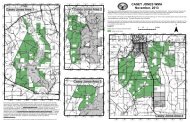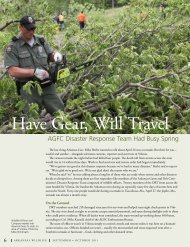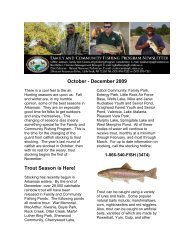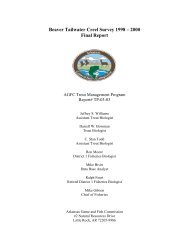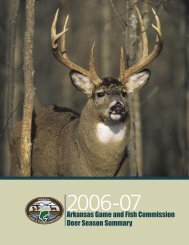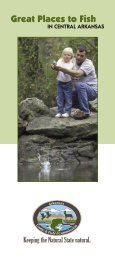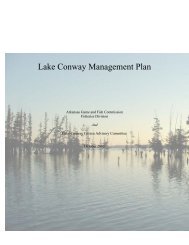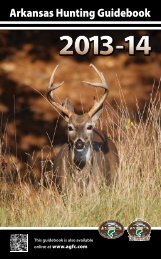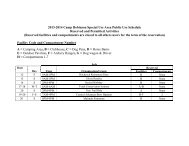View Article - Arkansas Game and Fish Commission
View Article - Arkansas Game and Fish Commission
View Article - Arkansas Game and Fish Commission
- No tags were found...
You also want an ePaper? Increase the reach of your titles
YUMPU automatically turns print PDFs into web optimized ePapers that Google loves.
<strong>Arkansas</strong>.“The minerals aren’t leached out ofthe surface soils as much as in Texas, somore calcium is taken up by the deer<strong>and</strong> the plants the deer feed on,” Baxtersaid. “The types of plants they have downthere are also extremely high in proteinalmost year-round, which lets them putheavy growth on their antlers throughoutthe spring <strong>and</strong> summer.”<strong>Arkansas</strong> AveragesIt’s not all gloom <strong>and</strong> doom. Plenty ofgood deer are taken each year on private<strong>and</strong> public l<strong>and</strong> in <strong>Arkansas</strong>. In fact,the biggest deer scored at <strong>Arkansas</strong>’s BigBuck Classic (the largest deer huntingexpo in the state) have been larger than200 inches on the Boone <strong>and</strong> Crocketscale during the last three years.“Those are some impressive deer,”Baxter said. “And we hear of plentyothers that people don’t take to thoseexpos or get officially scored. There’salready been one this year that greenscoredover 190 (inches) that was takenby a bowhunter.”Baxter said much of a buck’s antlersize depends on available forage <strong>and</strong> thenutrients in the soil that are transferredto the buck from the plants they eat.“Agricultural l<strong>and</strong> is rich in nutrientsthe bucks need to grow good antlers,”Baxter said. “Typically, <strong>Arkansas</strong>’s bestdeer come from areas with richer soils,such as the Delta, Crowley’s Ridge <strong>and</strong>the <strong>Arkansas</strong> River Valley. Every now <strong>and</strong>“Much of a buck’s antlersize depends on availableforage <strong>and</strong> the nutrientsin the soil that aretransferred to the buckfrom the plants they eat.”then a monster pops up in the Ouachitas,Ozarks <strong>and</strong> the pines of south <strong>Arkansas</strong>,but the average is always going to bebetter where the soil’s richer.”Thanks to years of data collected fromharvested bucks, Baxter can even give agood average of where deer in each partof the state will fall.“For 4½-year-old bucks in the Delta,the average Boone <strong>and</strong> Crockett scoreis somewhere close to 130 points, butfor 4½-year-olds in the Ozarks, you’relooking at an average score of 110 to 115points,” Baxter said. “You’ll still see someof those big deer that are much largerthan the average, like those on television.You’ll also have a few that are muchsmaller.”Balancing ActBaxter says there’s plenty of potentialfor an even better deer herd in <strong>Arkansas</strong>,but hunters have to help – the samehunters who complain about small buckshave no problem with does runningamok on their l<strong>and</strong>. When wildlifeagencies were trying to bring deer herdsback from the brink, does were protectedto increase populations. Now that deerpopulations are at all-time highs, theherd must be brought back into balance.Baxter says some areas may have 12to 20 does for every buck in the area. Allthose does compete for food with maturebucks, which decreases the health of theherd <strong>and</strong> hurts antler development.“The carrying capacity of l<strong>and</strong> isthe most deer an area will hold <strong>and</strong>keep healthy,” Baxter said. “But if you’relooking to increase antler size, you needto keep the herd at levels that promotemaximum productivity, which is muchlower than biological carrying capacity.”Too many does can affect the rut.“If the herd is balanced, you’ll have anoticeable rut with deer being very activein a short window,” Baxter said. “Butif the bucks are running around tryingto breed too many does, the rut will belong, drawn-out <strong>and</strong> much less visible.”All that extra work also impacts thebucks that are left at the end of the year.When the rut is over in late winter, thosedeer will be in bad shape during thetoughest time of the year. Some of thosebucks that were protected may not makeit to the next season.Aged VenisonAccording to Baxter, three thingscontribute to a deer’s antler growth: age,nutrition <strong>and</strong> genetics.“L<strong>and</strong>owners can do some things to12ARKANSAS WILDLIFE NOVEMBER • DECEMBER 2011




